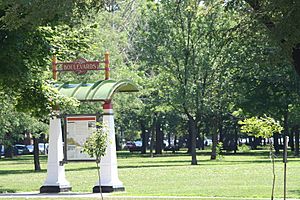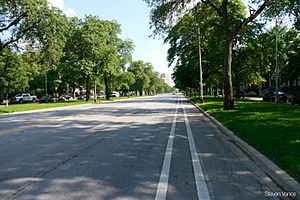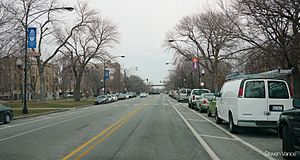Chicago park and boulevard system facts for kids
The historic Chicago park and boulevard system is a special network of parks in Chicago. These parks are connected by wide, tree-lined streets called boulevards. This system winds through the north, west, and south parts of the City of Chicago.
Some neighborhoods along this historic route include Logan Square, Humboldt Park, and Bronzeville. It stretches from Garfield Park in the west to Washington Park and Jackson Park in the south. The system also includes the Midway Plaisance, which was used for the 1893 World's Fair.
This amazing system was built between the 1870s and 1942. In 2018, about 26 miles of it were added to the National Register of Historic Places. It's important because it was the first complete system of green spaces for a major city in the United States.
Contents
History of Chicago's Park System
When Chicago became a city in 1837, leaders wondered how to create urban parks and connect them. In 1849, a real estate investor named John S. Wright suggested a large system of parks linked by drives. The state of Illinois approved this idea in 1869.
The original plan was to create a "ribbon of parks and pleasure drives encircling the city." The wide, green boulevards connecting the parks were also meant for fun and relaxation. They were like "parks spun out" into the city.
Even though it was planned as one big system, different groups built it. There were separate park commissions for the north, west, and south sides of Chicago.
This big 26-mile system was created for a few reasons. Leaders believed it would make neighborhoods healthier and more pleasant. It was also hoped that it would encourage people to build homes in what were then the edges of the city.
The park and boulevard system did attract new homes and businesses. It became one of Chicago's most famous features. This system was important because it was the first time Chicago planned its growth carefully on a city-wide scale. It helped organize new developments and made the city more beautiful and enjoyable.
Who Designed the Parks?
The South Park Commission's part of the system was designed by Olmsted, Vaux & Co. The main designers were Frederick Law Olmsted and Calvert Vaux. They also designed park systems for other cities, like Boston's Emerald Necklace. This part of Chicago's system includes the Midway Plaisance, used for the 1893 World's Fair. It also included boulevards leading to Washington Park and Sherman Park.
The West Chicago Commission's section was designed by William Le Baron Jenney. His 1871 plan connected Humboldt, Garfield, and Douglas Parks.
The North Side park commission, called the Lincoln Park Commission, tried to connect Diversey Parkway to the system. However, legal issues stopped them. By the time they could move forward, widening Diversey Avenue was too difficult.
Changes Over Time
In 1934, all the different park commissions joined together to form the Chicago Park District. Most of the park and boulevard system was finished by 1942.
Later, in 1959, the boulevards were given to the City of Chicago's street department. The Park District kept only the parks. In 2011, a competition called Network Reset was held to find new ideas for the Chicago boulevards.
Chicago Park Boulevard System Historic District
The Chicago Park Boulevard System Historic District includes most of the original system. It was added to the National Register of Historic Places in 2018. This protected area covers about 26 miles. It includes 8 parks, 19 boulevards, and 6 squares. It also protects nearby buildings built from the 1800s to the 1940s.
A part of the system was already recognized in 1985. This was the Logan Square Boulevards Historic District. It's a historic area in the Logan Square neighborhood on Chicago's North Side. It covers about 2.5 miles of the boulevard system. This includes parts of Logan Boulevard, Kedzie Avenue, and Humboldt Boulevard.
It also includes two parks, Logan Square and Palmer Square, which connect the boulevards. The Logan Square area boulevards pass through neighborhoods with many different styles of homes.
Several parks within the National Register district are also listed as historic places on their own. These include Garfield Park (listed in 1993), Humboldt Park (1992), Jackson Park and the Midway Plaisance (1972), Sherman Park (1990), and Washington Park (2004).




